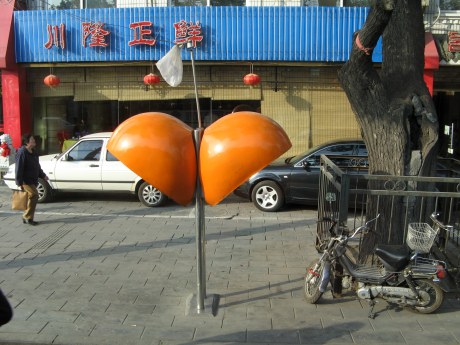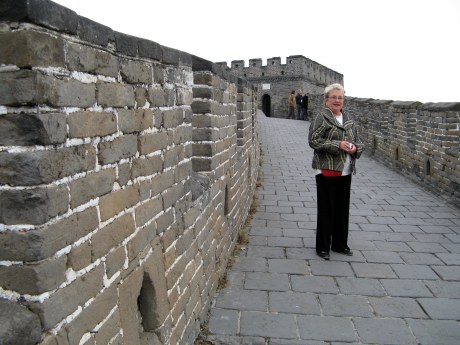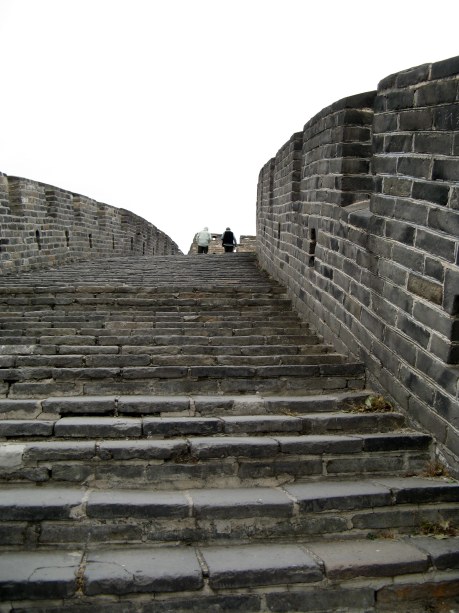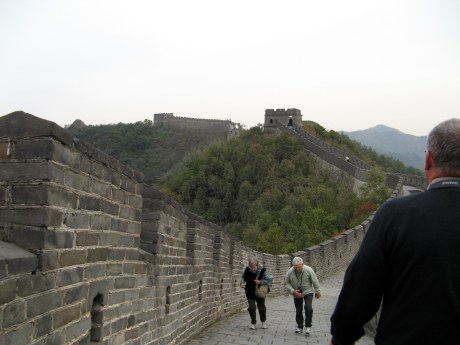Yesterday, our goal was to move to Leavenworth on the east side of the Cascades. A change of plans came as Jim studied the book and called Ford dealerships to learn all he could about transmissions. He settled on one of two transmission shops. The fix has waylaid us until we can get the Bronco repaired. I’m returning to my China Journal and pictures.

We left the restaurant and enjoyed the street scenes as we walked to our bus. This cute family was mobbed by we tourists. The wooden stroller is unusual to us and the boy in the middle with a bamboo backpack as well. Remember that you can click on any of these pictures to make them larger and see better detail.

This set of orange bonnets is a public phone booth; I expect, like ours, soon to be obsolete.

I’ve seen pictures of the Great Wall and thought of it as a smooth brick-like roadway. Up close, it is anything but smooth. Rugged, overpowering, stupendous, jagged, uneven, crooked, weathered. The section we visited is from 1400 A.D. The wall was started in 200 B.C. We are told the Chinese archeologists just discovered 500 kilometers more of rammed earth wall base previously unknown.

The soldiers/laborers who built it had varying skill. This rough,crooked stairway leads to one of the “guardhouses” that were built at regular intervals along the miles of wall. I had no idea the wall was manned. I thought just the height and steepness of it kept out intruders. The wall in various forms stretches over 5,000 miles.

The camera cannot take in the unbelievable reality of this wall undulating up and down the surrounding mountains for as far as the eye can see. It graces every mountain crest on China’s Mongolian border.

Numerous gates and exits allowed the soldiers and their families to go for water, tend their gardens, and hunt for food and gather wood. The guardhouses where they lived had very little privacy, no toilet or washing facilities, no doors and no windows, only openings that allowed the cold air to enter. Life in the guardhouses only sheltered them from rain and snow. In many places they were miles and miles from civilization.

Only some sections of the wall are maintained. In places, the bricks have fallen, have heaved and cracked or become overgrown with vegetation. The cost of maintaining the wall is enormous and thus neglected. Here we see the drainage system that carries water away from the walkway.

Each section has an individuality about it as you can see where one worker differentiated his placement slightly from another worker just 30 feet away.

On the Chinese side of the wall are remnants of fruit trees and gardens. The fruit trees have self seeded. On the enemy side of the wall, soldiers kept all vegetation cleared for 30 feet out from the wall so no enemy could approach unseen.

Seeing the Great Wall was worth the whole trip. We walked about a mile from one station to another and another. We met a couple with two children, all burdened with backpacks. They camped and walked the great wall for two weeks and saw many exciting sections that we on tours cannot see during our limited visit. I had no idea that camping on the great wall was an option.

Visiting the Great Wall was an emotional and unforgettable experience for me. Wikipedia has more precise information about the great wall.
http://en.wikipedia.org/wiki/Great_Wall_of_China

We left the restaurant and enjoyed the street scenes as we walked to our bus. This cute family was mobbed by we tourists. The wooden stroller is unusual to us and the boy in the middle with a bamboo backpack as well. Remember that you can click on any of these pictures to make them larger and see better detail.

This set of orange bonnets is a public phone booth; I expect, like ours, soon to be obsolete.

I’ve seen pictures of the Great Wall and thought of it as a smooth brick-like roadway. Up close, it is anything but smooth. Rugged, overpowering, stupendous, jagged, uneven, crooked, weathered. The section we visited is from 1400 A.D. The wall was started in 200 B.C. We are told the Chinese archeologists just discovered 500 kilometers more of rammed earth wall base previously unknown.

The soldiers/laborers who built it had varying skill. This rough,crooked stairway leads to one of the “guardhouses” that were built at regular intervals along the miles of wall. I had no idea the wall was manned. I thought just the height and steepness of it kept out intruders. The wall in various forms stretches over 5,000 miles.

The camera cannot take in the unbelievable reality of this wall undulating up and down the surrounding mountains for as far as the eye can see. It graces every mountain crest on China’s Mongolian border.

Numerous gates and exits allowed the soldiers and their families to go for water, tend their gardens, and hunt for food and gather wood. The guardhouses where they lived had very little privacy, no toilet or washing facilities, no doors and no windows, only openings that allowed the cold air to enter. Life in the guardhouses only sheltered them from rain and snow. In many places they were miles and miles from civilization.

Only some sections of the wall are maintained. In places, the bricks have fallen, have heaved and cracked or become overgrown with vegetation. The cost of maintaining the wall is enormous and thus neglected. Here we see the drainage system that carries water away from the walkway.

Each section has an individuality about it as you can see where one worker differentiated his placement slightly from another worker just 30 feet away.

On the Chinese side of the wall are remnants of fruit trees and gardens. The fruit trees have self seeded. On the enemy side of the wall, soldiers kept all vegetation cleared for 30 feet out from the wall so no enemy could approach unseen.

Seeing the Great Wall was worth the whole trip. We walked about a mile from one station to another and another. We met a couple with two children, all burdened with backpacks. They camped and walked the great wall for two weeks and saw many exciting sections that we on tours cannot see during our limited visit. I had no idea that camping on the great wall was an option.

Visiting the Great Wall was an emotional and unforgettable experience for me. Wikipedia has more precise information about the great wall.
http://en.wikipedia.org/wiki/Great_Wall_of_China
1 comment:
p0j32j9j62 o0j99r4h36 g6u70t2p10 u9e68e9z61 a4r13f5k13 a6n67t1n47
Post a Comment